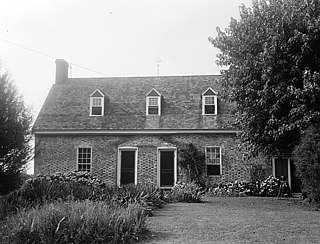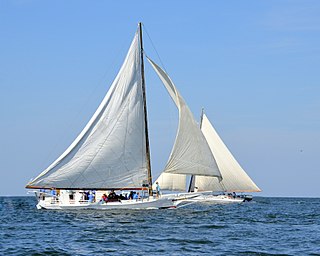
Crisfield is a town in Somerset County, Maryland, United States, located on the Tangier Sound, an arm of the Chesapeake Bay. The population was 2,515 at the 2020 census. It is included in the Salisbury, Maryland-Delaware Metropolitan Statistical Area. Crisfield has the distinction of being the southernmost incorporated city in Maryland.

The Kathryn, a Chesapeake Bay skipjack, was built at Crisfield, Maryland in 1901. Ported at Chance, Maryland, she is reputedly one of the fastest skipjacks on the Bay. She was designated a National Historic Landmark on April 19, 1994. She is one a small number of older skipjacks to survive in working condition.

The Princess Anne Historic District is located in Princess Anne the county seat of Somerset County, Maryland on Maryland's Eastern Shore. There has been little change due to industry or other development, and the town retains much of its historic character since its founding in the early 18th century. It has been the governmental center since the county was formed in 1742 and the present courthouse is one of the most architecturally distinguished in the state. Within the historic district are a few pre-Revolutionary structures, a high concentration of Federal and Victorian architecture, vernacular dwellings as well as 19th and early-20th century commercial and public buildings. The district contains approximately 270 structures of which nearly 90 percent are contributing to the character of the district.

The Berlin Commercial District is an historic district in Berlin, Worcester County, Maryland. It consists of a collection of approximately 47 late-19th century commercial buildings. They are small-scaled, one- to three-story buildings that occupy both sides of the main thoroughfare and its secondary arterials. The buildings form a visually cohesive and pleasing streetscape, the majority of which are constructed in the row fashion with party or common walls.

Make Peace is a historic home located at Crisfield, Somerset County, Maryland, United States.
Nelson Homestead, also known as the Elisha Riggin House, is a historic home located at Crisfield, Somerset County, Maryland. It is a "telescope" style frame house built circa 1836 by Crisfield shipbuilder Elisha Riggin. The Riggins are one of the Colonial families of Maryland who immigrated to the Chesapeake Colonies from Ireland in the mid 17th century and settled along Pocomoke Sound.

The Capt. Leonard Tawes House is a historic home located at Crisfield, Somerset County, Maryland, United States. It is a frame two story house begun in the second quarter of the 19th century and extensively altered in the Late Victorian mode through the rest of the century. Also on the property is a garage, a storage shed, a stilted frame dairy, and a gable-roofed frame privy.

The Ward Brothers' House and Shop is a historic home located at Crisfield, Somerset County, Maryland, United States. It consists of a two-story, two-bay, one-room plan frame dwelling built around 1880, and the brothers' barber shop, a composite building composed of individual structures grouped together behind a long false front. The brothers Lemuel T. Ward, Jr. (1896–1985) and Steve Ward (1895–1976) are recognized as the fathers of the modern movement in decorative wildlife, or decoy, carving in America.

The Crisfield Armory is a historic National Guard armory located at Crisfield, Somerset County, Maryland, United States. It is two stories tall with a full basement, emulates a Medieval fortification, and was built in 1927. Attached to the rear of this two-story main block is a narrower one-story drill hall. The front features a central section flanked by two, three-story tall towers. The State Seal of Maryland appears in a large square stone panel at the roofline, surmounted by three crenelles with stone caps. It is located within the boundaries of the Crisfield Historic District.
The F. C. Lewis Jr. is a Chesapeake Bay skipjack, built in 1907 at Hopkins, Virginia. She is a 39-foot-long (12 m) two-sail bateau, or "V"-bottomed deadrise type of centerboard sloop. She has a beam of 14.6 feet (4.5 m) and a register depth of 3 feet (0.91 m); her register tonnage is 6. She is one of the 35 surviving traditional Chesapeake Bay skipjacks and a member of the last commercial sailing fleet in the United States. She is located at Wenona, Somerset County, Maryland.

The Fannie L. Daugherty is a Chesapeake Bay skipjack, built in 1904 at Crisfield, Maryland. She is a 41.3-foot-long (12.6 m) two-sail bateau, or "V"-bottomed deadrise type of centerboard sloop. She is built by cross-planked construction methods and has a beam of 8 feet (2.4 m) and a depth of 3.6 feet (1.1 m). She one of the 35 surviving traditional Chesapeake Bay skipjacks and a member of the last commercial sailing fleet in the United States. She is located at Wenona, Somerset County, Maryland.

The Ida May is a Chesapeake Bay skipjack, built in 1906 at Urbanna or Deep Creek, Virginia. She is a 42.2-foot-long (12.9 m) two-sail bateau, or "V"-bottomed deadrise type of centerboard sloop. She has a beam of 14.4 feet (4.4 m), a depth of 3.3 feet (1.0 m), and a net register tonnage of 7. She is one of the 35 surviving traditional Chesapeake Bay skipjacks and a member of the last commercial sailing fleet in the United States. She is located at Chance, Somerset County, Maryland.
The Sea Gull is a Chesapeake Bay skipjack, built in 1924 at Crisfield, Maryland. She is a 46.6-foot-long (14.2 m) two-sail bateau, or "V"-bottomed deadrise type of centerboard sloop. She has a beam of 15.9 feet (4.8 m), a depth of 4.3 feet (1.3 m), and a net register tonnage of 10. She is one of the 35 surviving traditional Chesapeake Bay skipjacks and a member of the last commercial sailing fleet in the United States. She is located at Deal Island, Somerset County, Maryland.

Centreville Historic District is a national historic district at Centreville, Queen Anne's County, Maryland, United States. It contains an exceptional collection of 18th, 19th, and 20th century buildings chronicling the architectural development of an Eastern Shore of Maryland community. Among Centreville's residential, commercial, and ecclesiastical buildings are representative examples of the various architectural types and styles which characterized towns in the region during the period.

Academy Grove Historic District is a national historic district at Upper Fairmount, Somerset County, Maryland, United States. It comprises two Italianate-influenced frame buildings. These include the Fairmount Academy, constructed between 1860 and 1867 to serve as a public school for the Potato Neck District, and the Knights of Pythias Hall, erected adjacent to the Academy about 1872 by the Fairmount Lodge No. 77 of the Knights of Pythias. As early as 1883 the Knights of Pythias Hall was rented by the Board of Education for classroom space; when the Fairmount Lodge disbanded in 1911, the Hall continued to provide additional classroom space for the Academy.

Manokin Historic District is a national historic district at Princess Anne, Somerset County, Maryland, United States, located at the mouth of the Manokin River. It consists of the Manokin settlement, which forms a unique and visually interesting area of great historical significance on the Lower Eastern Shore. These structures, Clifton, More and Case It, Almodington, Elmwood, and Homewood are most strongly linked together visually, culturally, and historically. Architecturally the buildings span the period between the early 18th and the mid 20th centuries.

Upper Fairmount Historic District is a national historic district at Upper Fairmount, Somerset County, Maryland, United States. The district encompasses this quiet rural village situated along Fairmount Road. The village is landlocked, rural in character, and surrounded by farms, fields, wooded land and a few modern houses. Perhaps the most significant structure still standing is the Upper Fairmount Methodist Episcopal Church built in 1870.

Deal Island Historic District is a national historic district at Deal Island, Somerset County, Maryland, United States. The district encompasses the village of Deal Island. It includes Deal Island Harbor, still an active marina for fishing boats and an occasional skipjack. The 433-acre (1.75 km2) district contains 81 buildings and three cemeteries that contribute to its significance.

Hagerstown Commercial Core Historic District is a national historic district at Hagerstown, Washington County, Maryland, United States. The district consists approximately of a one and a half by two block rectangle which includes the major retail center of town. The center of the district is the public square and it is made up almost entirely of commercial buildings constructed or remodeled for retail purposes during the last 20 years of the 19th century and the first 20 years of the 20th century. Also in the district are the Washington County Courthouse and the City Hall.

The Cullen Homestead Historic District encompasses a cluster of properties associated with the Cullen family in rural Somerset County, Maryland. Located in the center of Hopewell, just northeast of Crisfield, the district has three main features. The first is, known as the Cullen Homestead, is a c. 1820 Federal style wood frame dwelling. The building has retained much of its interior period woodwork, despite being added to and altered over the years, and has retained its original board sheathing under modern aluminum siding. The second house in the district is a later 19th century house built by Jacob Hoke Cullen in 1880. The oldest part of the house is a T-shaped portion, which was roughly mirrored by a later addition around 1910, giving the house its present H shape. This house has also retained interior and some exterior finish work. The third element of the district is the family cemetery.





















